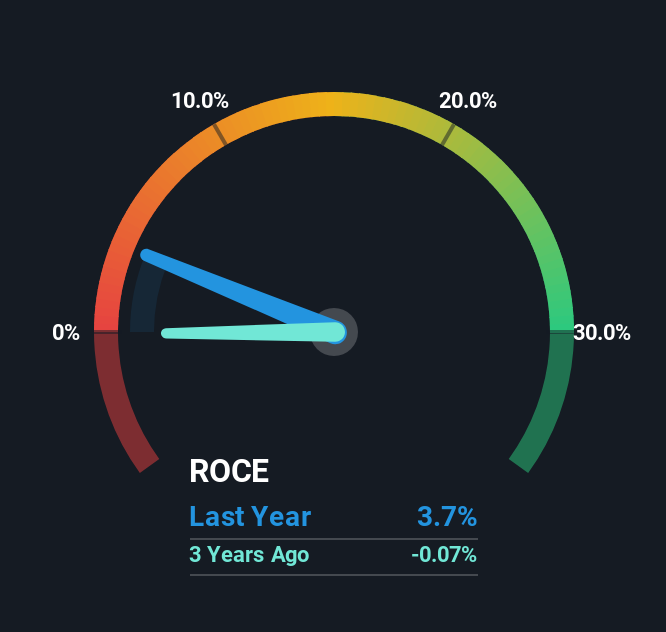If you're not sure where to start when looking for the next multi-bagger, there are a few key trends you should keep an eye out for. One common approach is to try and find a company with returns on capital employed (ROCE) that are increasing, in conjunction with a growing amount of capital employed. This shows us that it's a compounding machine, able to continually reinvest its earnings back into the business and generate higher returns. Speaking of which, we noticed some great changes in Keisei Electric Railway's (TSE:9009) returns on capital, so let's have a look.
Understanding Return On Capital Employed (ROCE)
For those that aren't sure what ROCE is, it measures the amount of pre-tax profits a company can generate from the capital employed in its business. To calculate this metric for Keisei Electric Railway, this is the formula:
Return on Capital Employed = Earnings Before Interest and Tax (EBIT) ÷ (Total Assets - Current Liabilities)
0.037 = JP¥34b ÷ (JP¥1.1t - JP¥193b) (Based on the trailing twelve months to June 2025).
Thus, Keisei Electric Railway has an ROCE of 3.7%. In absolute terms, that's a low return and it also under-performs the Transportation industry average of 5.2%.
Check out our latest analysis for Keisei Electric Railway

Above you can see how the current ROCE for Keisei Electric Railway compares to its prior returns on capital, but there's only so much you can tell from the past. If you'd like to see what analysts are forecasting going forward, you should check out our free analyst report for Keisei Electric Railway .
How Are Returns Trending?
We're glad to see that ROCE is heading in the right direction, even if it is still low at the moment. Over the last five years, returns on capital employed have risen substantially to 3.7%. Basically the business is earning more per dollar of capital invested and in addition to that, 21% more capital is being employed now too. The increasing returns on a growing amount of capital is common amongst multi-baggers and that's why we're impressed.
Our Take On Keisei Electric Railway's ROCE
All in all, it's terrific to see that Keisei Electric Railway is reaping the rewards from prior investments and is growing its capital base. Since the stock has only returned 24% to shareholders over the last five years, the promising fundamentals may not be recognized yet by investors. So exploring more about this stock could uncover a good opportunity, if the valuation and other metrics stack up.
Since virtually every company faces some risks, it's worth knowing what they are, and we've spotted 3 warning signs for Keisei Electric Railway (of which 2 can't be ignored!) that you should know about.
While Keisei Electric Railway may not currently earn the highest returns, we've compiled a list of companies that currently earn more than 25% return on equity. Check out this free list here.
Valuation is complex, but we're here to simplify it.
Discover if Keisei Electric Railway might be undervalued or overvalued with our detailed analysis, featuring fair value estimates, potential risks, dividends, insider trades, and its financial condition.
Access Free AnalysisHave feedback on this article? Concerned about the content? Get in touch with us directly. Alternatively, email editorial-team (at) simplywallst.com.
This article by Simply Wall St is general in nature. We provide commentary based on historical data and analyst forecasts only using an unbiased methodology and our articles are not intended to be financial advice. It does not constitute a recommendation to buy or sell any stock, and does not take account of your objectives, or your financial situation. We aim to bring you long-term focused analysis driven by fundamental data. Note that our analysis may not factor in the latest price-sensitive company announcements or qualitative material. Simply Wall St has no position in any stocks mentioned.
About TSE:9009
Keisei Electric Railway
Engages in the provision of public railway transportation services for local communities in Japan.
Fair value with low risk.
Market Insights
Community Narratives




